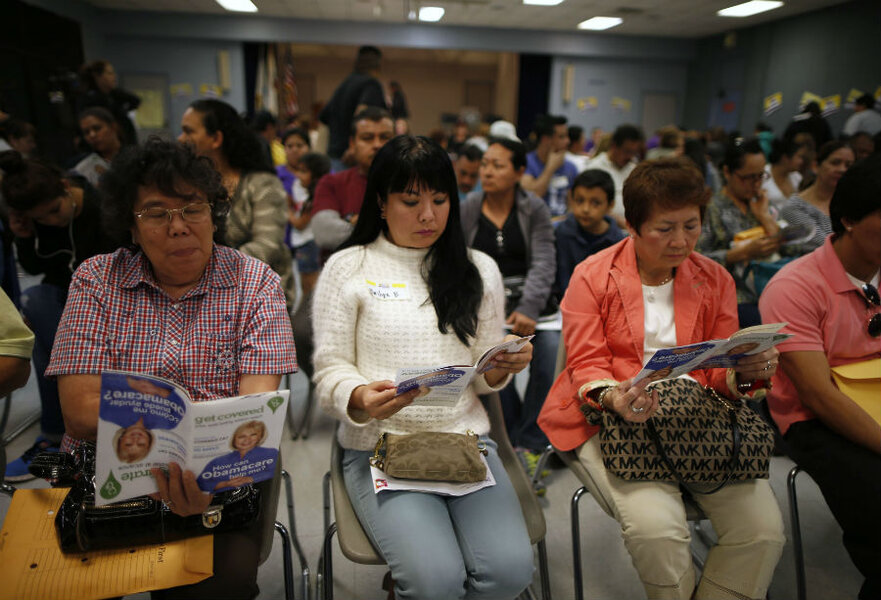What will the Obamacare premium hike mean for you?
Loading...
At first glance, next year’s 25 percent average premium price hike on mid-cost health-care plans offered under the Affordable Care Act seems staggering. But a deeper look reveals a more nuanced and hopeful picture for American health coverage leading up to the so called “Obamacare” open enrollment period that will run Nov. 1 through Jan. 31.
For one thing, the steep hikes won't affect everyone. A majority of Americans get insurance through their employers. For others, who buy their insurance independently through ACA exchanges, average premiums in about half of US states will stay competitive with or even slightly cheaper than the premiums paid by the employer-covered group.
“In areas where there’s quite a bit of competition from insurers, the premiums are still going to be pretty reasonable,” Linda J. Blumberg, healthcare expert at the Urban Institute, a Washington think tank, points out.
In dense, urban areas where many insurance companies compete for customers through the exchanges, prices are going to be lower than they will be in sparse, rural areas with only one insurer. Either way, says the Obama administration, 77 percent of Americans will still be able to find plans for less than $100 a month after federal subsidies for low-income people.
Of the 11 million Americans who bought health plans on the federal exchanges through June of this year, 84 percent used federal subsidies to help defray the cost, according to the US Department of Health and Human Services (HHS), which announced the premium increases Monday.
However, this still leaves many people vulnerable to the price spike, including those who don’t qualify for subsidies and those who live in areas where there is little or no competition among insurers.
And some of those hikes are quite steep. As The New York times pointed out in one example:
In Raleigh, N.C., 18 plans are available for 2017 from two insurers, but the premiums could be a substantial expense for some consumers. For a 53-year-old man with income of $53,000 a year, the cheapest midlevel silver plan will cost $714 a month, or $8,568 a year, according to the federal website, and no subsidy would be available.
But a man of the same age with income of $25,000 a year could get a subsidy of $639 a month, reducing his premium to $75 a month, or $900 a year.
There are several reasons behind next year's average price increase, which dwarfs the 2 percent average hike for 2015 – one year after the ACA launched – and the 7 percent increase for 2016.
First, fewer people than expected have signed up for Obamacare. In 2015, the Congressional Budget Office projected that 21 million people would participate in the federal exchanges by 2016. But the Obama administration projects that monthly enrollment will average just 11.4 million in 2017, despite the threat of federal tax penalties for not having health coverage.
Second, those who do sign up for coverage on the exchanges tend to be less healthy (and therefore more costly to insure) than those who don't. Obamacare bars providers from turning away people with pre-existing conditions, which has raised insurers’ costs and cut into their profits. For the last three years, the government has had a risk adjustment program in place to account for this issue – insurers carrying less risk pay in, while those with more risk get paid – but that program will expire this year.
As a result, some of the nations' biggest insurers, including Aetna and UnitedHealthcare, have pulled out of most of the state exchanges because they weren’t profitable.
Now, that combination of low-enrollment, high costs, and three years of premiums that insurers set at lower rates than what federal forecasters had predicted when the law was first introduced, has prompted insurers to raise premiums to rebalance things.
“This year, with two years of cost data available, issuers are adjusting their premiums to bring them in line with costs,” writes the Department of Health and Human Services in a Monday report outlining the premium increases.
However, based on historical trends, we should not see another huge price spike in the future, Ms. Blumberg predicts. “If these insurers were really adjusting for differences in risk that they hadn’t been expecting, well now they’ve done it,” she says.
Another factor that could lead to lower long-term costs: Millions of people who were allowed to stay on their pre-Obamacare health plans in 2014, instead of buying ones that comply with the new law, will lose those "grandfathered" plans in 2017. These people tend to be healthier, says Blumberg, judging by the fact that they were able to get good health plans in the first place. If they buy health coverage through the ACA – instead of through an employer or directly through their insurer – the ratio of sick to healthy customers could balance out.
But ultimately, ACA’s future will depend on what happens on Nov. 8. A Clinton presidency likely would mean an expansion of the ACA, including more tax credits and potentially a “public option,” or a more affordable government-run plan option in all states. Meanwhile, if elected, Donald Trump says he would repeal the ACA in favor of expanded health savings accounts, 100 percent deductible insurance premiums, and insurance policies sold across state lines.








